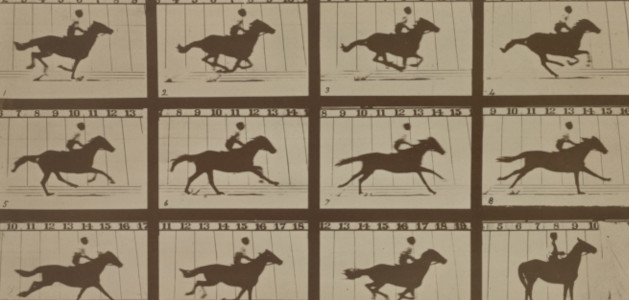
Fast and fun ways to learn the basics

While creating animations takes time, it doesn't have to be difficult to get started. Great animations can consist of simple movements repeated over and over with few or minor modifications.
Use these ideas to inspire your first (and next) animation and build the confidence and skills necessary for future animation masterpieces.
Visual poetry is a fun way to analyze word choice and explore meaning and vocabulary. Finding an image that represents a single line or couplet can help students decode and grasp subtleties in word choice that make poetry so powerful.
While poems like Frost's "The Road Less Traveled" are favorites of teen angst, poetry that speaks to student's lives, like "We Real Cool" by Gwendolyn Brooks, or "Last Night I Drove a Car" by Gregory Corso, can help motivate them to dig deeper.
Explore more visual poetry examples
If students won't be motivated by poetry, consider poetic song lyrics. For example, you could play "Caged Bird" by Alicia Keys and show how this contemporary song pulls imagery from "Sympathy" by Paul Lawrence Dunbar.
Have students read, reread, and explore the words in each line of the poem while discussing the author's meaning and intent. Then, have students create a visual poem that includes the poem along with illustrations, photos, voice narration, and music consistent with the emotions the poem evokes.
The only animated movement is the switch between scenes or pages, but it helps students begin to see how animation is a successive series of frames. This transition between frames is what makes movement possible in animations.
While the process of research, writing and storyboarding is different, the digital storytelling process is similar. Have your students take in 5-10 pictures, put them in order to tell a personal story and record narration.
If you want to get students started learning the techniques of stopmotion animation, a music video is a great place to start. It doesn't matter if you are use clay, LEGO bricks, or cut paper!
Have small teams choose a song from a favorite band or a list you share with them. Students can develop a character to sing or play music. Teams can work to locate plastic instruments or get crafty with chenille stems, bottle caps, and paper.
Take 6-10 pictures of the clay characters singing and playing instruments against a colorful background. Import the entire folder of images to start building the animation. Then, duplicate the frames until you have enough to play through the entire the soundtrack. Rearrange the order of frames so the video isn't too repetitive.
Once students have created a movie this way, they could use the same process to create a personification story. Simply choose an object to personify and capture images to tell the story of one of its adventures.
Inspire students with Marcel the Shell with Shoes on.
While 3D rendering is likely outside of your time and budget constraints, all students have watched cartoons and very few don't outright love them. Use this fascination to motivate them to take risks and produce their own illustrations.
Digital tools, especially vector-drawing tools, make it easy to create illustrations that are easy to change. Even raster tools have layers that make it easy to move one picture over the top of another.
Have students create a self-portrait using a digital art tool. Make a copy of the illustration and adjust the mouth to either open or close it, depending on their first image. Now, have them record narration and duplicate the frames they created to match the narration.
To help her elementary students identify verbs, Texas educator Amy Clark asked her students to create a "Verbs are Words that Move" animation project. After choosing a verb and animating it, she also asks her students to come up with a "fancy" word, or synonym, for their verb.
Once students understand the basics, set them loose to create their own animated stories!
Editor's Note: This article originally appeared on the Tech4Learning blog on December 9, 2014.

Follow us on Instagram for daily inspiration

Create a thought web, cluster, flowchart, or other graphic organizer for a lesson
8 first projects to get students using technology
Creative, digital book reviews
Fun and powerful ideas with animated characters

Wixie
Share your ideas, imagination, and understanding through writing, art, voice, and video.

Rubric Maker
Create custom rubrics for your classroom.

Pics4Learning
A curated, copyright-friendly image library that is safe and free for education.

Wriddle
Write, record, and illustrate a sentence.

Get creative classroom ideas delivered straight to your inbox once a month.
Topics